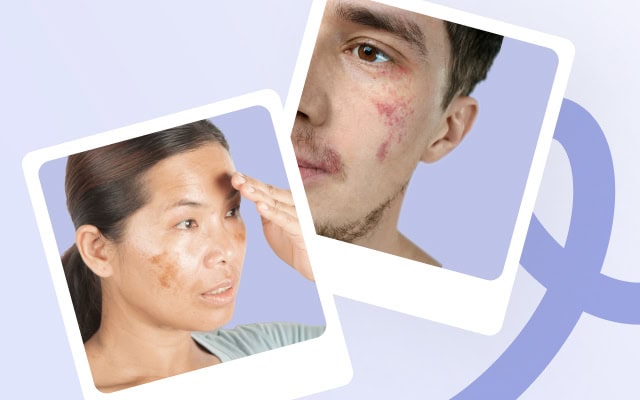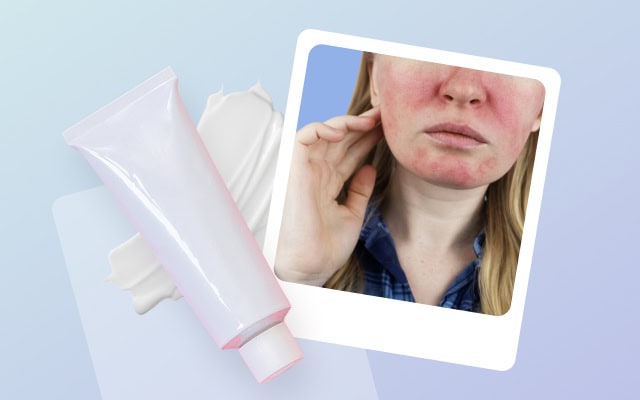What are the best creams, ointments and antihistamines for urticaria?
Dr. Alpana Mohta, board-certified dermatologist, talks about the differences between acute and chronic urticaria (hives), the treatment options for each, and tells you how to secure a prescription.
Table of Content:
What are hives? | When should I see a doctor? | Do I need a prescription? | Over-the-counter (OTC) creams for hives | OTC antihistamines for hives | Prescription medications for urticaria | FAQ
Our commitment to producing high-quality content:
The information presented in this article is based on scientific research and the professional advice of our Content Medical Reviewers, who are experts in the field of Dermatology. How we write our content →
What is urticaria (hives)?
Hives, also known as urticaria, are a type of skin reaction that presents as red, itchy welts on the skin. These welts can vary in size and shape and can appear anywhere on the body.
Urticaria is an immunological disease that can be inducible or spontaneous in nature. Inducible urticaria or hives are often caused by an allergic reaction to substances like food, medication, insect bites, or other irritants. Sometimes, they can also be triggered by stress, infections, temperature variation, or a sign of other underlying health conditions like thyroid disease. Spontaneous urticaria, on the other hand, is idiopathic in nature–without a known trigger or underlying cause.
The itchiness associated with urticaria can be particularly uncomfortable. In most cases, hives are temporary and resolve on their own or with the help of antihistamines, which reduce itching and swelling. However, chronic hives can persist for longer periods, and their cause is often more difficult to identify.
If hives are accompanied by more severe symptoms like difficulty breathing, and abdominal pain medical attention should be sought immediately, as it may indicate a more serious allergic reaction called anaphylaxis1.
When to see a dermatologist for hives?
Dr. Mohta says you should also consult a dermatologist if your hives cover a large area, spread rapidly, persist for more than a few days, recur frequently, or are accompanied by other symptoms like fever, joint pain, or significant swelling. Chronic hives may indicate an underlying condition. If over-the-counter antihistamines do not relieve symptoms, or if hives significantly interfere with daily activities, a healthcare provider can offer further treatments
Do I need a prescription for an urticaria treatment cream?
Dr. Mohta says that many cases, urticaria can be managed with over the counter creams. However, if you have chronic hives (which last six weeks or longer) you will probably need a prescription.
How to get treatment for hives?
You can a have a photo-consultation with a board-certified dermatologist affiliated with Miiskin, which only costs around $59. Once you submit the photo-consultation, they will send your treatment plan and prescription in less than 2 days
Secure, confidential, and reviewed by board-certified dermatologists.
What is the best cream for urticaria?
Dr. Mohta says that in many instances, when managing hives, the use of topical treatments can help alleviate the itching and discomfort, although oral antihistamines are more commonly recommended as the first line of defense.
- Calamine lotion: This can help soothe the itching and discomfort caused by hives. It has a cooling effect that can be quite relieving.
- Antihistamine creams or gels: These can help to block the action of histamine (the chemical that causes hive symptoms) directly at the site of the rash. Examples include creams containing diphenhydramine.
- Pramoxine hydrochloride and menthol lotion: Pramoxine hydrochloride has been an FDA-approved anti-itch agent since 1953. Studies have validated its effectiveness in relieving itchiness. These provide a cooling effect and can numb the skin, which helps to relieve itching and irritation.
- Aloe vera: Pure aloe vera gel can be soothing and has anti-inflammatory properties. It can help calm the skin and reduce redness and itching.
- Hydrocortisone cream: Over-the-counter 1% hydrocortisone cream can reduce inflammation and itching. However, it should be used sparingly, not over a large body area and only for a short period.
What are the best over the counter antihistamines for hives?
Dr. Mohta says that if topical over-the-counter creams and lotions are not enough, antihistamines are first-line treatment for hives due to their effectiveness and relative safety as they help to reduce or block the histamine release that causes the itching, redness, and swelling associated with hives.
The choice of medication often depends on the severity of the symptoms, the frequency of outbreaks, and the presence of any side effects. It is important for patients to work with their healthcare provider to determine the best medication and dosage for their specific situation.
Over-the-counter antihistamines for urticaria
- Zyrtec (Cetirizine): A second-generation antihistamine that is less likely to cause drowsiness. It provides 24-hour relief from hives.
- Allegra (Fexofenadine): Also a second-generation antihistamine, known for causing minimal sedation, making it a good choice for those who need to avoid drowsiness.
- Claritin (Loratadine): Another non-sedating, second-generation antihistamine that provides 24-hour relief from the symptoms of hives.
These antihistamines are generally preferred for their lower propensity to cause drowsiness compared to first-generation antihistamines, making them suitable for use during the daytime and for individuals who need to remain alert.
What are the best prescription antihistamines and oral medications for chronic hives?
If you have hives in a wide spread area of your body, your symptoms last longer than six weeks or you do not respond to over the counter antihistamines, there are some prescription medications that your dermatologist can prescribe for the treatment of severe or chronic hives such as prescription antihistamines, H2 Blockers, Leukotriene Receptor Antagonists, Oral corticosteroids, and Xolair (Omalizumab)10.
Antihistamines for chronic hives (H1 Blockers)
- Xyzal (levocetirizine): A more potent derivative of cetirizine, it’s available by prescription and is effective in treating skin reactions including hives11.
- Clarinex (Desloratadine): has similar benefits but is usually chosen for more severe cases12.
- Atarax (Hydroxyzine): This is a first-generation antihistamine that is stronger and more sedating, often used for short-term management of severe hives, especially when symptoms disrupt sleep13.
H2 Blockers
When used for hives, H2 blockers are used as adjunct therapy to antihistamines.
- Zantac (Ranitidine): Previously one of the most popular choices, ranitidine has been withdrawn from many markets due to concerns about impurities linked to cancer risks.
- Pepcid (Famotidine): This is now the most frequently recommended H2 blocker for hives, due to its effectiveness and better safety profile compared to ranitidine.
- Tagamet (Cimetidine): Although less commonly used than famotidine, cimetidine is another option that can be effective for treating hives in combination with an antihistamine14.
- Axid (Nizatidine): Similar to the others, though less commonly used and available, it can be an option for treating hives.
Leukotriene Receptor Antagonists
- Singulair (Montelukast): Singulair is the most frequently prescribed LTRA for chronic urticaria when additional control beyond antihistamines is needed. It works by blocking leukotrienes, chemicals in the immune system that contribute to inflammation, swelling, and bronchoconstriction15. This medication should be used under medical supervision to monitor for potential side effects.
Oral corticosteroids
Oral corticosteroids are sometimes used for treating severe or persistent hives (urticaria), particularly when antihistamines and other standard treatments do not provide sufficient relief.
- Prednisone, prednisolone and methylprednisolone: These are one of the most commonly prescribed corticosteroids for hives due to its effectiveness and relatively quick action. They are often used for short-term treatment to manage acute flare-ups of hives16.
- Dexamethasone: This corticosteroid is occasionally used for severe cases due to its strong anti-inflammatory properties. It is typically reserved for very brief treatment periods to minimize side effects17.
While oral corticosteroids are highly effective in managing hives, they are generally used for the shortest possible duration to control flare-ups because of the potential for serious side effects with long-term use, such as osteoporosis, weight gain, diabetes, cataract, hypertension and increased risk of infections.
Xolair (Omalizumab)
Xolair is the first FDA-approved biologic treatment for chronic hives, when the cause is unknown. Xolair targets the underlying causes of symptoms, offering significant relief. Studies show that patients receiving treatment experienced a 67% reduction in both itch severity and hives, after 12 weeks of urticaria treatment18.
Can hives be diagnosed via a photo-consultation with a dermatologist?
Dr. Mota says that hives can often be diagnosed through photo-consultations with a dermatologist, especially when the characteristic appearance of the welts—red, raised, and often itchy patches that may change shape or size—is clear in the images.
Get treatment for hives via Miiskin
Have a consultation with a board-certified dermatologist via Miiskin. You just need to take some high-resolution photos of your skin, answer the questions, enter your payment method and pay for the consultation. Miiskin dermatologists usually reply in 24 hours, but it can take up to 48 hours for them to respond. After that, you can collect your prescription at your pharmacy of choice.
Secure, confidential, and reviewed by board-certified dermatologists.
What triggers hives?
Dr. Alpana Mohta, board-certified dermatologist, says that urticaria can be triggered by various factors that lead to the release of histamine and other chemicals from cells in the skin. These factors can be broadly categorized into allergic reactions, physical triggers, and other underlying conditions. Here are some common triggers of hives:
- Allergic reactions to foods (nuts, shellfish, eggs, milk, spicy food, etc.)
- Skin reaction to certain things (plants, pets, soaps, laundry detergents, etc.)
- Medications (aspirin, non-steroidal anti-inflammatory drugs, penicillin, etc.)
- Emotional stress
- Insect stings or bites
- Tight clothing
- Sun exposure
- Extreme weather (cold, heat/sweat)
- Hormonal changes
- Infections (viral and bacterial infections of any kind)2 3
- Hepatitis4
- Mononucleosis5
- Autoimmune response for conditions like lupus6 or thyroid disease7
- Gastrointestinal disorders like celiac disease8 or inflammatory bowel disease9
What else can I do to minimize the itchiness caused by hives?
Dr. Mohta says that in addition to taking over the counter or prescription antihistamines you can also use some home remedies to control the symptoms.
Cool compresses
Applying a cool, wet cloth to the affected area can soothe the skin and help reduce the urge to itch. This can provide immediate, albeit temporary, relief.
Use a lotion or ointment for urticaria
Lotions containing calamine, menthol or pramoxine can soothe the skin and reduce itching. Ointments with menthol or pramoxine can also help numb the area, providing relief.
Loose clothing
Wear loose, light clothing to avoid irritation to the affected areas, and use natural fabrics such as cotton, avoid using synthetic fibers which can exacerbate the symptoms.
Stress management
Since stress can trigger or worsen hives, engaging in stress-reducing activities like deep breathing exercises, yoga, or meditation might be beneficial.
Hydration
Drinking plenty of fluids helps keep the skin hydrated and may aid in recovery.
Avoiding direct sun exposure
Sun exposure and high temperatures can trigger a form of urticaria called cholinergic urticaria. Therefore, practice strict sun protection and stay in cool shaded areas.
Secure, confidential, and reviewed by board-certified dermatologists.
Lee éste artículo en Español Urticaria aguda vs urticaria crónica
Article References:
https://www.mdpi.com/2227-9059/11/4/1096
https://acaai.org/allergies/allergic-conditions/skin-allergy/hives/
https://www.aad.org/public/diseases/a-z/hives-causes
https://www.healthline.com/health/your-rash-caused-by-hepatitis-c
https://www.verywellhealth.com/mono-rash-5183869#
https://www.verywellhealth.com/lupus-and-hives-5267973
https://www.healthline.com/health/ciu/chronic-hives-and-thyroid-connection
https://www.verywellhealth.com/celiac-disease-gluten-sensitivity-linked-to-skin-issues-563126
https://www.healthline.com/health/ulcerative-colitis-skin-rash
https://www.aafp.org/pubs/afp/issues/2017/0601/p717.html
https://pubmed.ncbi.nlm.nih.gov/16445787/
https://www.webmd.com/drugs/2/drug-7681/hydroxyzine-hcl-oral/details
https://www.mayoclinic.org/diseases-conditions/chronic-hives/diagnosis-treatment/drc-20352723
https://pubmed.ncbi.nlm.nih.gov/20945604/
https://pubmed.ncbi.nlm.nih.gov/32139204/
https://www.xolair.com/chronic-spontaneous-urticaria.html
Skin conditions and treatments
Articles reviewed by dermatologists
Facial treatment for seborrheic dermatitis
How to get rid of rosacea permanently?
How to calm a rosacea flare-up fast?
Spongiotic dermatitis: What is it and what is the best treatment?
A dermatologist’s guide to psoriasis medication





 Still dealing with skin issues? Get expert help from home.
Still dealing with skin issues? Get expert help from home.
